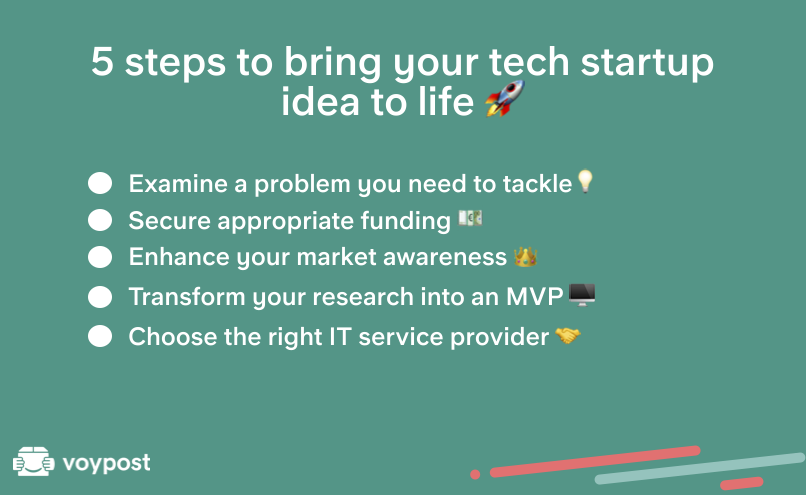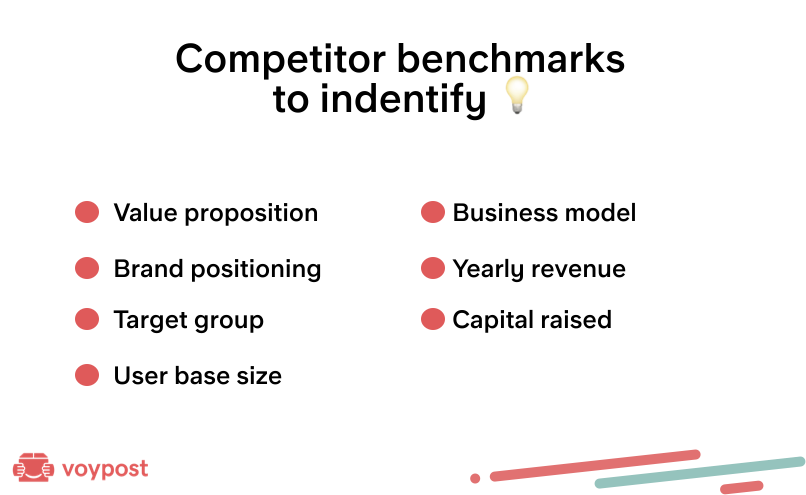5 steps to bring your tech startup idea to life in 2022
The tech product market has been gaining more popularity, but the question remains: "How do I start a tech company and bring idea to life?"
March 26, 2022
9 min read

Do you have a realization that this is the moment to enter the market with a genuinely useful product destined to be a success? It only needs to be detailed, developed and wrapped up. Welcome to the club of startup founders.
It is not the right place to start up a spelling debate (startup or start-up?) so we will just skip that.
The start-up meaning is as follows: it is a business venture that might still be in the fund-raising stage or operating for a couple of months already.
So what is a startup company? It is a legal entity that corresponds to the definition above.
What is a business venture? Basically, any activity is meant to engage buyers and thus generate profit.
Every business venture starts with an idea. The phrase, ‘I want to start a business but have no ideas’, sounds absurd because if you have no business ideas of your own, you are inevitably forced to help someone else’s ideas flourish. In other words, you’re an employee. You sign the backside of the check.
Now that we’re done with definitions, let us proceed with references and startup business tips that hopefully will help you launch your own business venture from scratch.
Tech or non-tech?
In general, there is no difference in the approaches you would use between the two. In this article, we focus on tips on how to create a tech startup and the related startup stages.
We assume that you start a new business from scratch. Let us list the four ways to become a business owner, to demonstrate all the options:
The startup building;
Inheriting a business;
Purchasing a franchise;
Purchasing a business.
The first way obviously might entail budget restrictions, the lack of skill and personnel, legal hindrances, etc. We’ll do our best to address these concerns.
So, how to start a tech startup?

Step #1: Examine a problem you need to tackle
They say the first of the startup phases is “Ideating”. Let us not be fooled by the seeming simplicity of the word. It might appear as if musing about a wonderful product is a low-effort activity that is responsible for at least half of your eventual success.
Simon Sinek suggests starting with WHY. Your “why” is simultaneously the motivation and the reason to build a particular product. Even if this particular product meets a cold response, your motivation will still persevere, opening up a way for new product ideas and protecting you from disappointment.
Motivation (or inspiration, for that matter) is the primary resource to back up your business venture.
“Sell flashlights” is a bad reason/goal/motivation. “Help people safely do their job in the dark” is much better. If you have a product idea already, ask yourself why you want to do it nonetheless. On the other hand, if you have the why, ask the next question: HOW? And finally, WHAT?
These questions correspond to the simple marketing formula: Idea-Form-Placement; and the answers might serve as a business plan draft.
Step #2: Secure appropriate funding
Every business venture is unique, and the challenges entrepreneurs face require creative solutions. However, money is a common restriction for start-up ventures, a serious one, and it must be dealt with accordingly.
So ask yourself if you have enough and how much more you need. Then, determine the source of financing.
Self-backed: you and your friends have spent all the pocket money and retirement savings to fund the project. Make sure to legally settle down any possible disputes over the profits that may arise in future
State-backed: research for the local startup support programs. The aid might be completely non-refundable, which means you won’t have to pay it back. If you can persuade the officials, of course.
Investor-backed: you’ve been in the trenches long enough to find a person who is willing to pour loads of cash into your venture and has faith in you. Be ready to comply with the Terms and Conditions of such assistance.
Crowdfunded: appeal directly to the target audience. You have been active on social media lately, haven’t you? Then your audience will gather the necessary amount in the first two hours after the start of the Kickstarter funding campaign.
It doesn’t hurt to mix up the sources of backing but the number of obligations will rise accordingly.
At this stage, you might righteously ask, what about the business plan? What if an angel investor asks you for one (which they will)? ‘Oh, I have this awesome logo here, on a napkin!’ It’s a no-go.
Step #3: Enhance your market awareness
A lengthy business plan will require you to. It may be more or less formal, but the typical structure is as follows:
Abstract.
The products and services section that gives a detailed description of the problem you address and how you address it. The product features fall into this section. This is also where you define competitors and technology partners, using their examples as a proof of success or to demonstrate the superiority of your product.
Market study: market size, market value – any metrics that comprehensively describe your target audience and their needs; also, the trends that will boost the sales of your product if you occupy the niche in time.
Marketing strategy: ads, platforms, SEO tools, product pricing, retention strategy, supply chains. This section describes how you’d deal with success. You also should think through the situation when the plan does not work out as intended.
Team: the introduction to the chain of command, their skills, and achievements.
Appendices: charts, tables, and all.
There’s a debate going on: is a business plan worth the time and effort? Yes and no.
If your business already works, albeit, on a tiny scale, you only need to state just that on the paper: ‘My business model works, the demand exceeds the proposition. All I need the money for is to scale’. Still, it has to be persuasive, and it might take a couple of pages.
What must an entrepreneur do after creating a business plan? Look for investments and be ready to forget their BP when things go awry.

Step #4: Transform your research into an MVP
This section concerns software tech products specifically.
Here is a quick reference concerning the MVP meaning while we move on.
The concept of MVP is simply inappropriate for hardware products, so look into the prototyping and mockup building tools instead. It is necessary to pick the respective development methodology; then, in turn, stick to the development lifecycle.
Depending on the product nature and the preferences of your team, pick the methodology and development frameworks if you haven’t already.
We wish we could provide a one-size-fits-all list of things needed to start a business but this is not how it works. It could be 7 stages of a new product development process, for example, or any other one. However, the last thing you want at this stage, before the actual business launch, is to be overwhelmed by suggestions and guidelines. You could spend hours brainstorming the SWOT diagram of the upcoming product, filling in the value proposition canvas or watching the startup series on YouTube, and doing your best to consider both 4 Ms and 4 Ps frameworks in your marketing.
What you might want to do instead is, rely on what you already know, carefully and slowly determine the weak spots and deficiencies, and then research and implement the respective solutions.
Perhaps even more importantly, delegate the tasks your team cannot handle alone.
You might lack IT-related experience or expertise and thus be forced to hire a remote developer to build a startup MVP – this one-time gig might buy you a loyal teammate, by the way.
The bulkier projects would require a whole MVP software development team. This is when you might choose to outsource your efforts, and it is important to spend some time researching the software development service providers if so.
Step #5: Choose the right IT service provider
Both tech and non-tech startups benefit from technological solutions. If the project budget allows, you might afford an app launch to engage the mobile device users or automate the repetitive tasks and free up the creative force of your team.
Regardless of the purpose, it is guaranteed that somewhere on the globe there is a team that has accomplished similar development tasks and will finish yours in a pinch. Don’t miss out on the opportunity to save up to 50% of the development expenditures or more, depending on your country of residence. How much does it cost to build an app?
Australian startup founders fly over to Singapore to meet with their remote colleagues in person for a reason, and this is just one example that proves the worth of outsourcing.
There are tons of the “Top X outsourcing companies” on the Internet, the broker companies, and aggregators. If the general search yields no results, run a specific query that relates to the task at hand (for example, “LCD controller development company”), and something should pop up.
Wrapping Up
There are thousands of snags that might hold your emerging business back. When it comes to choosing the exact steps on how to launch a startup, the final decision is yours. For sure, we can greatly simplify the MVP development step, bringing you a bit closer to the dream.